Rotational Motion
Objectives
-
•to study the basic concepts of rotational motion such as torque and moment of inertia
-
•to validate the conservation of energy law
Equipment
- a large, 6 inches in radius, aluminum disk attached to the rotary motion sensor
- meter stick
- set of small masses from 20 g to 50 g
-
•The radius of the large-sized pulley is 2.387 cm.
-
•The radius of the medium-sized pulley is 1.432 cm.
Introduction and Theory
In this experiment, we will study the effect of a constant torque on a symmetrical body. We will determine the angular acceleration of a disk. From this, we will measure its moment of inertia, which we will compare with a theoretical value. We will also study how energy is conserved in this sort of system. The apparatus for this experiment is shown in fig. 1. It consists of a large disk that is mounted on the PASCO rotary motion detector unit. The unit has several pulleys on it. We have a string that is wound on the pulley on which we hang various masses. The experiment will consist of winding the string up, and then allowing the mass to fall and unwind the string. During this, the angular velocity of the disk will increase to a maximum. When the mass reaches the bottom of the string, the rotating disk will wrap the string back up until the disk has zero angular velocity. The height that the mass reaches on its way up will be nearly the same as the starting point because energy is almost completely conserved. From all of this, you will measure the angular acceleration, determine the moment of inertia, and check if the Law of Conservation of Energy holds in this system.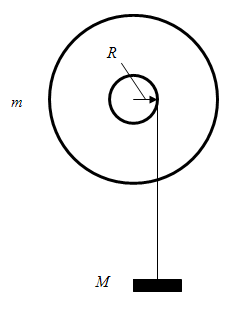
Figure 1: The experimental setup for the Rotational Motion lab
( 1 )
Στ = Iα,
I =
mr2,
where m is the mass of the disk and r is the radius of the disk.
Measure α and use it to calculate I, which you will need to compare with the theoretical value of I. A typical graph produced in DataStudio® for this experiment is shown in fig. 2, below.
| 1 |
| 2 |
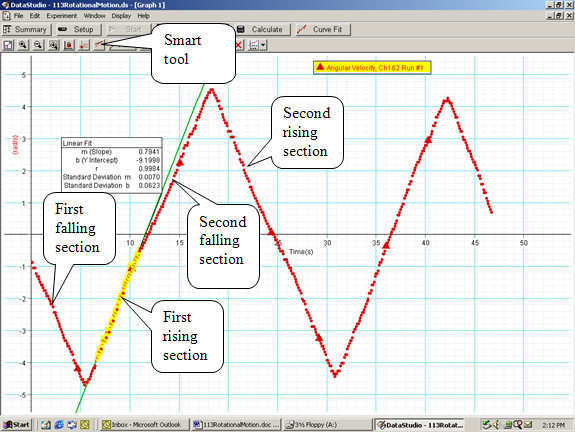
Figure 2: A sample file in DataStudio®
| 1 |
| 4 |
Equations of Motion
When the mass is falling, the equation for rotational motion is( 2 )
Στ = RTf − τF = Iαf,
( 3 )
Στ = RTr + τF = Iαr.
Στ = Iα,
, 2Στ = RTf − τF = Iαf,
, and 3Στ = RTr + τF = Iαr.
can be solved to give
( 4 )
I =
− MR2 ≈
.
| MgR |
| α |
| MgR |
| α |
Energy
When the mass begins to fall, the gravitational potential energy will transfer to the kinetic energy.Potential Energy
The change in potential energy can be found using the equation:( 5 )
ΔPE = PEf − PEi,
( 6 )
PEi = Mghi
( 7 )
PEf = Mghf
ΔPE = PEf − PEi,
, 6PEi = Mghi
, and 7 PEf = Mghf
can be solved to give:
( 8 )
ΔPE = Mg(hf − hi).
Kinetic Energy
The change in kinetic energy can be found using the equation:( 9 )
ΔKE = KEf − KEi,
( 10 )
KEi =
| Iωi2 |
| 2 |
( 11 )
KEf =
| Iωf2 |
| 2 |
KEi =
and 11| Iωi2 |
| 2 |
KEf =
into 9| Iωf2 |
| 2 |
ΔKE = KEf − KEi,
, we will get:
( 12 )
ΔKE =
−
.
| Iωf2 |
| 2 |
| Iωi2 |
| 2 |
Conservation of Energy
The total mechanical energy is conserved in the frictionless system, which means the following.( 13 )
−ΔPE = ΔKE
( 14 )
−Mg(hf − hi) =
−
| Iω2f |
| 2 |
| Iω2i |
| 2 |
Procedure
Please print the worksheet for this lab. You will need this sheet to record your data.1
Calculate the theoretical value for the moment of inertia for the disk.
2
Open the pre-set experiment file: labs/PreSetupfiles/PHY113.
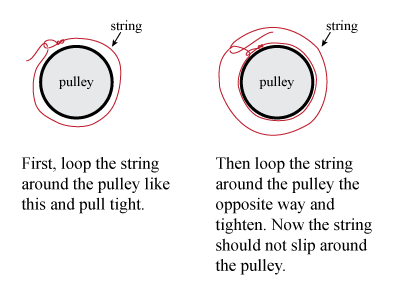
Figure 3: Attaching the string correctly.
3
Record the angular velocity vs. time data for the following cases.
-
Astring wound around the medium pulley, M = 50 g
-
Bstring wound around the medium pulley, M = 70 g
-
Cstring wound around the large pulley, M = 50 g
-
Dstring wound around the large pulley, M = 70 g
-
Estring wound around the large pulley, M = 100 g
4
To find the angular acceleration α for a certain part of the motion, select the corresponding segment of the data on the graph and apply the linear fit to it. In each case, to calculate the experimental value of the moment of inertia, remember to use the averaged angular acceleration α from 4 (or more, but an even number) sections of the plot.
5
For one of the runs, determine if the energy is conserved by comparing the maximum change in potential energy with the maximum change in kinetic energy.
-
AMeasure the distance that mass M falls from the starting point (kinetic energy is zero and the potential energy is maximum) to the bottom of the fall (kinetic energy is maximum while the potential energy is minimum) with the metric ruler provided. Use masking tape to mark initial and final position.
-
BTo collect the data of the maximum angular velocity, use the "Smart tool" feature or "Statistics" in the angular velocity vs. time graph.
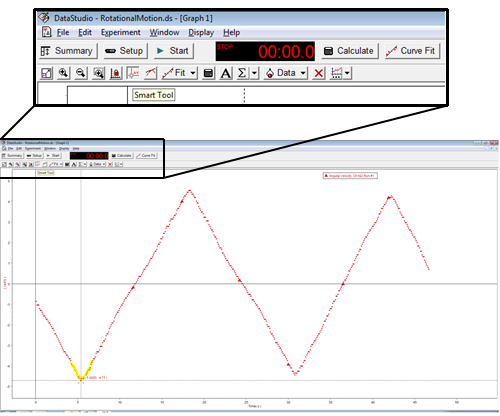
Figure 4a: How to measure the maximum velocity - Smart Tool.
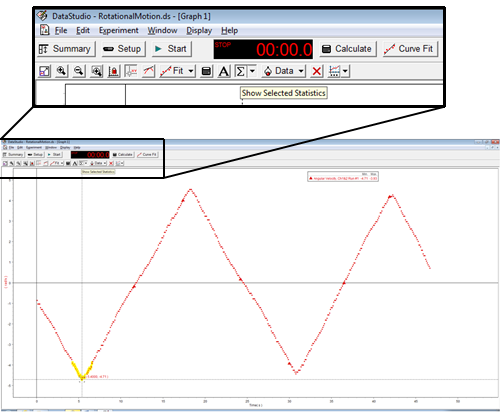
Figure 4b: How to measure the maximum velocity - Statistics.

